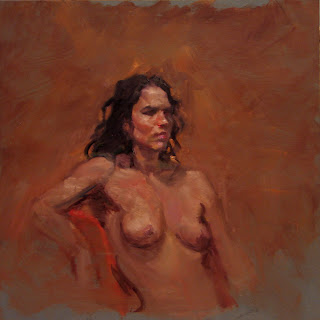Starving Artist Survival Tip

Well, as anyone can see from these photos, I am not starving. However, if I were able to sell more paintings I would take the money and buy painting panels from the store, rather than make them myself. That said, other artists often ask me about my homemade panels, so what follows is a how-to.
The boards I use are 1/4 inch thick MDF available in 2 x 4 foot panels from the lumber store. Crucially, these sheets are actually slightly larger than this, so that after accounting for sawcut wasteage you can end up with round-number dimensions for the panels- in other words you can actually make eight panels exactly 12 inches by 12 inches from one of these sheets.
I like a medium-gray shade as a starting color for my paintings. This allows you to start painting with light colors from the beginning, rather than laboriously building up darks or medium-value colors on a white ground. A bucket of white gesso can be tinted with a little black gesso to get the gray you want.
The gesso is applied in three coats, and the boards are sanded after each coat. On this occasion I tried to save some time by applying the first two coats with a roller and brushing on by hand only the last coat. This did save a lot of time, but the resulting surface was not as smooth as what three coats of brushed-on gesso gives you. Next time I will use some smoother roller covers, to see if that makes a difference. The sandpaper is 220 grit, but maybe something finer, like 320, might be better for the final coat. An electric palm sander makes the job easier than sanding by hand.
Painting panels made of MDF or other sheet material are most suitable for small paintings, maybe at most 20 x 16 inches. My goal was to have a quantity of panels in three sizes: 12 x 16, 12 x 12, and 12 x 9. I began by ripping the store-bought sheets in half (you really need a table saw to do these cuts cleanly).

The rest of the cuts were also done with the table saw, except for the 16-inchers, which I did with a circular saw, cutting through multiple pieces at once (below).

A day's work and about $75 in materials produced close to 100 panels ready for oil paint. This is an average of about 75 cents each, compared with an average price of $6 each if you bought them from an art supply store.

Now, the next time another painter asks me about my panels, I can hand over my business card and say, "Please go to my blog, and look up the post for June 12, 2012."




Comments